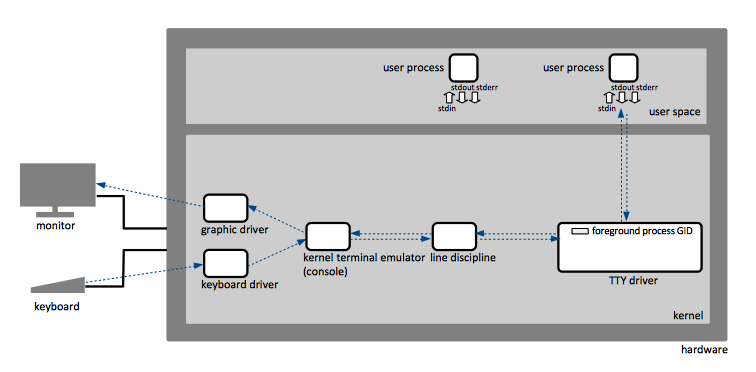Linux TTY
External
Internal
Overview
"TTY" is a Linux subsystem that provides the conduit through which keyboard strokes captured while the focus is in a terminal such as iTerm2 or xterm are turned into the right characters and delivered to UNIX processes. At the same time, the TTY subsystem funnels the process' generated output back to the terminal. The name comes from "teletype", which used to be electro-mechanical machines that read keyboard entires, turned them into electrical signals and sent them across the wire to to other teletypes.
TTY Functions
Line Editing
TTY subsystem provide line editing services, where a backspace key actually removes the last typed character from an internal editing buffer, instead of being sent to the user process. This functionality is implemented by a component known as line discipline. Line discipline also contain options for character echoing, automatic conversion between CR and LF, flow control, etc. User processes have the choices of disabling this functionality, by putting the line discipline in "raw" mode, instead of the default "cooked" (or "canonical") mode. The kernel provides several line disciplines, but only one is attached to a given serial device at a time.
Session Management
TTY session management allows one user to interact with multiple processes running simultaneously in user space, one at a time. This includes the capability to suspend, kill or send programs to background, bring programs into foreground, and direct the user input to the foreground process only. The TTY subsystem implements these features in the TTY driver.
Blocking I/O
The TTY maintains a kernel data buffer, and when the buffer is full, the write call executed by the processes that try to write will block, moving the writing process in an interruptible sleep state.
TTY Device Components
The TTY subsystem has several kernel components, listed below. Together these are known as a "TTY device", or sometimes just "TTY". Each TTY has a corresponding character device under /dev. When a user logs in on a particular TTY, that user must become the owner of the device file. The actual ownership is set by the login programs that runs with root privileges.
The character device file for the TTY associated with a certain process is shown by ps as TTY.
Line Discipline
A kernel-level component providing line editing capabilities.
TTY Driver
The TTY Driver is a kernel component that implements session management. The TTY driver does not have an execution context - it has data fields and methods, but the data gets updated only if the methods get called by a process or a kernel interrupt handler. As such, the driver maintains the foreground process group ID, but in a passive way, updated by the session leader. It also keeps track of the size of the connected terminal, passively, updated by the terminal emulator. The TTY driver may be associated with several processes but only the processes that are part of the foreground group will receive input from the TTY. Likewise, only the foreground job will be allowed to write to the TTY device.
Terminal Emulator
A terminal emulator can be implemented in kernel - as it is the case for the Linux console, or in user space, as it is the case for text-based user interfaces such as iTerm2 or xterm. The need to move the terminal emulation in user space, while still keeping the TTY subsystem that provides session management and line discipline, led to the development of pseudo terminals.
Pseudo Terminals
A pseudoterminal ("pseudo TTY" or "PTY") is a pair of pseudo-devices (a master and a slave) that provide a communication channel. They emulate a physical computer text terminal. Writing to the master is exactly like typing on a terminal, thus the master pseudo-device can be thought of a physical computer text terminal.

